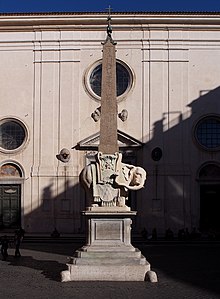Elephant and Obelisk
| Elephant and Obelisk | |
|---|---|
 | |
| Artist | Gian Lorenzo Bernini |
| Year | 1667 (1667) |
| Catalogue | 71 |
| Type | Sculpture |
| Medium | Marble |
| Subject | Elephant |
| Location | Piazza della Minerva, Rome |
| Coordinates | Coordinates: 41°53′52.74″N 12°28′39.26″E / 41.8979833°N 12.4775722°E / 41.8979833; 12.4775722 |
Elephant and Obelisk is a sculpture designed by the Italian artist Gian Lorenzo Bernini. The elephant was probably executed by his assistant Ercole Ferrata; the Egyptian obelisk was uncovered during nearby excavations.[1] It was unveiled in February 1667 in the Piazza della Minerva in Rome, adjacent to the church of Santa Maria sopra Minerva, where it stands today.
The image possibly originated from the Hypnerotomachia Polyphili of 1499. Various preparatory drawings done by Bernini exist. One version in Windsor Castle, UK was probably done in the 1630s when Cardinal Francesco Barberini wished to place an Egyptian obelisk in front of his family palace, the Palazzo Barberini. Nothing came of this specific project, but Bernini revived the idea in the 1660s, when Pope Alexander VII, Fabio Chigi, wished to build a similar monument after another Egyptian obelisk had been discovered in Rome.
Various other concepts were explored for this later commission as attested by preparatory drawings. It is likely that the drawings were used so that the patron could make a decision about which design he wanted. This include a drawing (in Leipzig) of the figure of Time holding a scythe and simultaneously the obelisk. In the Vatican Library there are two pen and ink drawings with other figures holding up the obelisk, including one of Hercules, and another with various allegorical figures supporting the spire.[2] A third version in the Vatican Library shows Bernini adapting on the concept he created in the 1630s, although he added in a larger base, changed the direction of the elephant's orientation, and made its face appear more friendly than ferocious.[3]
It turned out to be the last commission Pope Alexander VII would ask of Bernini, as he died in May 1667. He was succeeded by Pope Clement IX.
On 15 November 2016, Rome authorities announced they were searching for vandals who broke the left tusk the previous Sunday night and left the piece nearby. Mayor Virginia Raggi said that they will assess the damage to determine how to best reattach the fragment.[4]
The statue makes a brief but prominent appearance in the Italian neorealist film Umberto D. (1952). It also features as a motif in the novel Adua by Igiaba Scego (2015).
Contents
1 Gallery
2 See Also
3 References
4 Further reading
Gallery

Three-quarter view

Close-up view from the west

View from below

Obelisk at the Piazza della Minerva, Rome.

Elephant at the Piazza della Minerva, Rome.

View against the façade of Santa Maria sopra Minerva
The second Obelisk [of the pair of the Elephant and Obelisk], Urbino
See Also
- Apries
- Sais
- List of obelisks in Rome
- Urbino Obelisk
References
^ Heckscher, William S. (1947). "Bernini's Elephant and Obelisk". Art Bulletin. XXIX (3): 155–182. (Subscription required (help))..mw-parser-output cite.citation{font-style:inherit}.mw-parser-output q{quotes:"""""""'""'"}.mw-parser-output code.cs1-code{color:inherit;background:inherit;border:inherit;padding:inherit}.mw-parser-output .cs1-lock-free a{background:url("//upload.wikimedia.org/wikipedia/commons/thumb/6/65/Lock-green.svg/9px-Lock-green.svg.png")no-repeat;background-position:right .1em center}.mw-parser-output .cs1-lock-limited a,.mw-parser-output .cs1-lock-registration a{background:url("//upload.wikimedia.org/wikipedia/commons/thumb/d/d6/Lock-gray-alt-2.svg/9px-Lock-gray-alt-2.svg.png")no-repeat;background-position:right .1em center}.mw-parser-output .cs1-lock-subscription a{background:url("//upload.wikimedia.org/wikipedia/commons/thumb/a/aa/Lock-red-alt-2.svg/9px-Lock-red-alt-2.svg.png")no-repeat;background-position:right .1em center}.mw-parser-output .cs1-subscription,.mw-parser-output .cs1-registration{color:#555}.mw-parser-output .cs1-subscription span,.mw-parser-output .cs1-registration span{border-bottom:1px dotted;cursor:help}.mw-parser-output .cs1-hidden-error{display:none;font-size:100%}.mw-parser-output .cs1-visible-error{font-size:100%}.mw-parser-output .cs1-subscription,.mw-parser-output .cs1-registration,.mw-parser-output .cs1-format{font-size:95%}.mw-parser-output .cs1-kern-left,.mw-parser-output .cs1-kern-wl-left{padding-left:0.2em}.mw-parser-output .cs1-kern-right,.mw-parser-output .cs1-kern-wl-right{padding-right:0.2em}
^ Wardropper, p29
^ Lorenzo, Bernini, Gian. "The Obelisk of the Minerva". www.theeuropeanlibrary.org. Retrieved 2018-02-26.
^ Palazzo, Chiara (15 November 2016). "Rome in shock as Bernini elephant statue vandalized". The Daily Telegraph. Agence France-Presse. Retrieved 15 November 2016.
Further reading
- Dickerson, Claude Douglas, Anthony Sigel, and Ian Bruce Wardropper. 2012. “Bernini : Sculpting in Clay : [exhibition, Metropolitan Museum of Art, New York, October 3, 2012 - January 6, 2013, Kimbell Art Museum, Fort Worth, February 3 - April 14, 2013]
- Cooke, H. L. ‘Three Unknown Drawings by G. L. Bernini’. The Burlington Magazine 97, no. 631 (1 October 1955): 320–323. doi:10.2307/871723.
Heckscher, William S. ‘Bernini’s Elephant and Obelisk’. The Art Bulletin 29, no. 3 (1 September 1947): 155–182. doi:10.2307/3047128- Napier, David A. ‘Bernini’s Anthropology: A “Key” to the Piazza San Pietro’. RES: Anthropology and Aesthetics no. 16 (1 October 1988): 17–32. doi:10.2307/20166799
- Popham, A. E. ‘Bernini’s Drawings of Elephants’. The Burlington Magazine 97, no. 633 (1 December 1955): 391. doi:10.2307/871675
- Posèq, Avigdor W. G. ‘The Physiognomy of Bernini's Elephant’. Source: Notes in the History of Art 22, no. 3 (1 April 2003): 35–46. doi:10.2307/23206724.
This sculpture article is a stub. You can help Wikipedia by expanding it. |






